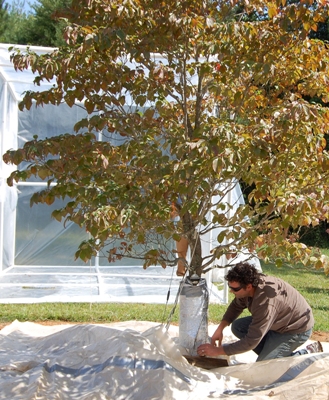Nov 1 2012
Using dogwood trees, scientists are gaining a better understanding of the role photosynthesis and respiration play in the atmospheric carbon dioxide cycle. Their findings will aid computer modelers in improving the accuracy of climate simulations.
 Jeff Warren and a team of ORNL researchers track the rate of carbon flow through deciduous trees, which will provide data for improved climate models.
Jeff Warren and a team of ORNL researchers track the rate of carbon flow through deciduous trees, which will provide data for improved climate models.
"The Department of Energy is very interested in experimentalists working with the climate modelers to improve the fidelity of the climate models," said Jeff Warren, a scientist in Oak Ridge National Laboratory's Environmental Sciences Division. "The models are essentially building these trees using equations, but the models may be more simplistic than they should be."
ORNL researchers are trying to determine how much carbon dioxide deciduous trees remove from the atmosphere and convert into energy, and where they store this energy. Trees and humans rely on similar types of energy. While we eat carbohydrates - which are merely chains of carbon-rich sugars - trees make their carbs by removing carbon dioxide from the atmosphere.
In mid-September, Warren and a team of seven other scientists at ORNL began the last of three carbon-tracking experiments on a stand of dogwood trees at the University of Tennessee Forest Resources Research and Education Center in Oak Ridge. Using a rare and traceable form of carbon dioxide made with a stable carbon isotope, ORNL researchers were able to label trees individually, creating a pulse of carbon that could be tracked as it moved through a tree — a process similar to how doctors track sugars moving through humans during a PET scan.
Carbon enters the tree through the leaves, and over the course of a few days, travels through the tree's branches, trunk and so on. The researchers follow the carbon by sampling new leaves, old leaves, fruit, stem tissue, roots and soil.
"Carbon flow within plants has always been studied but has never fully been understood," Warren said. "Our experiment will help us understand the fate of carbon dioxide after it is taken into a plant. It'll show us which structures receive the carbon and how quickly the carbon travels through the system."
The research team isolated each tree using a structure built from hollow PVC pipes and wrapped in clear film from a local hardware store. Although these tent-like structures appear to be primitive, they are much more high-tech than they seem, complete with air conditioning and environmental monitoring equipment.
Acting like mobile greenhouses, the structures encase the trees, allowing researchers to release the valuable carbon dioxide label without the gas escaping into the atmosphere.
The scientists exposed four dogwood trees to the traceable carbon dioxide individually for about two hours. After labeling, they removed the greenhouse structure and covered two of the trees with a shade-cloth to reduce photosynthesis. This provided them with two different light treatments, which will be useful for assessing how well carbon uptake is represented in the climate models. The experiment was repeated in the spring, summer and fall to determine how the seasons affect carbon dioxide use by trees.
"The supercomputing model sends a fixed amount of carbon to growth and to the roots, but it doesn't send any carbon to reproductive structures like berries or seeds, or symbiotic fungi associated with the roots," Warren said. "Depending on the season, this can account for quite a bit of carbon removed from the atmosphere that the model is completely disregarding."
Additional studies on carbon use in plants are needed to determine the true impact of the ecosystem on climate change.
"When we consider that a large portion of the land surface of the Earth is covered by deciduous forests, small changes in how carbon is cycled between the forest and the atmosphere can make a large difference when predicting climate change," said Colleen Iversen, a staff scientist and ecosystem ecologist in ORNL's Environmental Sciences Division. "Models are what we use to project what the climate could look like in 100 years, so it is important for climate change scientists like us to really make sure that the model processes are representing what's happening in the natural world."
Eventually, the researchers hope to incorporate their data into the publicly available Community Land Model, one of several models linked together to show interactions between atmosphere, ocean, land and ice in the larger Community Earth System Model. Researchers worldwide run the coupled model on supercomputers at Oak Ridge and elsewhere to better understand climate change.